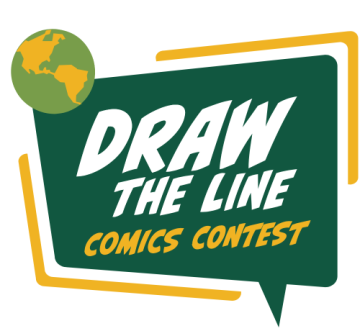The Brief

In recognition of the Year of the Environment, William & Mary Libraries invites students to explore climate futurism through visual media for the second annual W&M Libraries Draw the Line Comics Contest. For this year's contest, your comic should show a possible future - aspirational or dystopian - for our environment.
The Draw the Line Comics Contest affirms the importance of the creative arts as a means to transmit knowledge and informed commentary. The contest utilizes the dynamic medium of comics to empower participants to explore and challenge the boundaries of creativity and innovation. We aim to promote W&M Libraries as both a resource for and partner in research and creation in all forms and disciplines. Winners of last year's contest can be found in ScholarWorks.
The overall winning submission and runners-up in each of the three categories will receive $750 and $250, respectively. Winning submissions will be digitally preserved and displayed by W&M Libraries.
Comics Contest Submission Form - Submit by November 30, 2025
- WHO is eligible to submit
-
This contest is limited to current William & Mary students. Individual and group submissions are both welcome, though prize money will be allocated per submission, not per individual. Only one submission is accepted per individual/group.
- WHAT needs to be submitted
-
Comics Creation and Submission Guidelines
Submit a single-page document that includes all of the panels. Follow the directions below for the document sizes and DPIs that we accept for submissions.
The comic can be in either color or black & white.
For submissions, we accept .jpg, .jpeg, .png, or .pdf files that are either digitally-made entries downloaded from a creation/design tool or physically-made entries that are scanned for digital submission.
You are strongly encouraged to make an appointment with the Reeder Media Center on the ground floor of Swem Library for technological assistance in downloading, scanning, or submitting your entry.
Acceptable Document Sizes with Necessary DPI
Please follow this table for page sizes and required DPI.
Sizes DPI 11” x 17” 600 dpi 9” x 12” 1200 dpi 8.5” x 11” 1300 dpi 6” x 9.5” 1800 dpi Scanning at the Reeder Media Center
Work can be scanned using Workstation 3 at the Reeder Media Center on the ground floor of Swem Library. Book the Workstation 3 scanner online in advance to reserve your spot. Ask for help at the service desk with moving the scanner. The software app “VueScan” can be used on the computer to scan the work and make sure that the scanning resolution is set according to the dpi guidelines above. If assistance is needed with this step, consult a student employee at the service desk.
All completed entries should be submitted through the contest form.
Full Submission Guidelines
Comics must consist of only your own original work (read: no AI or borrowed content).
Each submission needs to be accompanied by an artist statement with any citations. The artist’s statement should address the following and be around 250-500 words:
- What area of the environment did you focus on for this comic? What inspired your imagined future?
- What do you hope readers/viewers come away with after encountering your comic?
- Was there anything unique about your process of creating this comic that you’d like others to know about?
- Citations: Include a list of source(s) consulted in gathering background information for the future imagined in your comic, in your preferred citation format (e.g. APA, MLA).
If you have any technical questions about submitting your comic, please email aebecker@wm.edu, embellamy@wm.edu, or rnhogan@wm.edu.
- HOW the comics will be evaluated
-
All submissions will be judged by a panel of W&M Libraries staff and University faculty on the following criteria:
- Creativity
- Evidence of research
- Connection to theme
- Clarity of artist statement
- Innovative use of the comic medium
- WHAT prizes are available
-
The contest will have one overall grand-prize winner who will receive $750.
Three runners-up will also be identified in the categories of:
- Best visuals
- Best story
- Best evidence of research
and will receive $250 per submission.
- WHEN does the contest run
-
The submission portal opens on October 13, 2025, and runs through Sunday, November 30, 2025. Winners will be notified in December 2025 or January 2026, and a celebration of contest winners will be held in the Spring 2026 semester.
- HOW can interested students get more information
-
For questions, contact Alexis Becker, Liz Bellamy, and Rachel Hogan, contest chairs.
The Inspiration Behind This Year’s Theme
The 2025 calendar year at William & Mary is dedicated to the Year of the Environment, inviting our campus to consider and celebrate William & Mary's commitment to safeguarding the environment and the communities that depend on its health and resilience.
Envisioning the climate of the future can lead to a spectrum of creative expressions, from dystopian representations of a world damaged beyond repair to hopeful portrayals that highlight the climate's resilience and what can happen when a tiny seed of change is given the chance to blossom. Whatever you imagine when you think of the future of our environment, we want to know.
Perhaps you take adrienne maree brown's principle of "small is all" to heart, or draw inspiration from acts of climate resilience that are happening already across the globe. Perhaps you envision an alternate future that radically departs from our current ways of living in communion with nature. Maybe you find wisdom in Indigenous teachings and anticipate how adopting traditional practices can heal the climate. Or maybe you take something that troubles you about our society now and imagine how it might ultimately affect our future Earth. Your perspective on our future is up to you.

